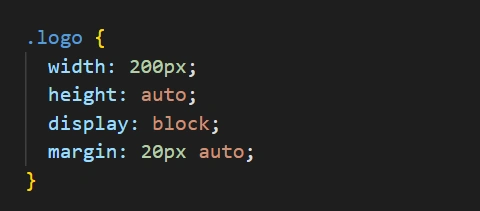How to Add Logo in CSS: Adding a logo to your website is essential for branding and visual identity. CSS makes it easy to style and position logos effectively. In this article, we’ll explore different ways to add and style a logo in CSS, ensuring a professional and polished look.
Basic Logo Styling Using CSS
To style a logo image, you can use the <img> tag selector in CSS. Here’s a simple example:
img {
width: 200px;
height: 100px;
margin-top: 10px;
margin-left: 20px;
}
Explanation:
- “ – Sets the width of the logo.
- “ – Defines the height of the logo.
- “ – Moves the image 10 pixels downward.
- “ – Moves the image 20 pixels to the right.
Using CSS Classes for Logo Styling
Instead of using the <img> selector directly, it’s best to apply a class to the logo for better customization:
.logo {
width: 200px;
height: auto;
display: block;
margin: 20px auto;
}
<img src="logo.png" alt="Website Logo" class="logo">
Why Use Classes?
- Increases reusability and maintainability.
- Allows more flexibility in styling.
Positioning the Logo
Proper positioning ensures that your logo appears in the right place on your webpage. Here are different positioning techniques:
Centered Logo
.logo {
display: block;
margin: 0 auto;
}Fixed Logo on Top Left
.logo {
position: fixed;
top: 10px;
left: 20px;
}Absolute Positioning for Precise Control
.logo {
position: absolute;
top: 50px;
left: 100px;
}Making the Logo Responsive
To ensure the logo adapts to different screen sizes:
.logo {
max-width: 100%;
height: auto;
}This ensures that the logo resizes dynamically without distortion.
Adding Hover Effects to the Logo
To make your logo interactive, you can add hover effects:
.logo:hover {
opacity: 0.8;
transform: scale(1.1);
}Comparison Table: How to Add Logo in CSS
| Method | CSS Property | Best Use Case |
|---|---|---|
| Basic Styling | width, height, margin | Simple layouts |
| Centering | margin: auto | Placing in the center |
| Fixed Positioning | position: fixed | Sticky header logos |
| Absolute Positioning | position: absolute | Precise placement |
| Responsive Design | max-width: 100% | Mobile-friendly layouts |
Conclusion: How to Add Logo in CSS
How to Add Logo in CSS or Styling a logo in CSS is simple yet crucial for a professional-looking website. By adjusting the width, height, positioning, and responsiveness, you can ensure a visually appealing and functional design.
FAQs
How do I make my logo responsive?
Use max-width: 100% and height: auto in CSS to ensure the logo scales properly on different screen sizes.
What’s the best way to position a logo in CSS?
It depends on your layout. Use position: fixed for a sticky logo, position: absolute for precise placement, or margin: auto for centering.
How can I add a hover effect to my logo?
Use the :hover pseudo-class in CSS to change properties like opacity or scale when the user hovers over the logo.
Can I use SVG for a logo instead of an image?
Yes! SVGs are scalable and resolution-independent, making them great for logos.
Why isn’t my logo showing up on the webpage?
Ensure the file path is correct in the src attribute and that there are no typos in the filename or extension.







